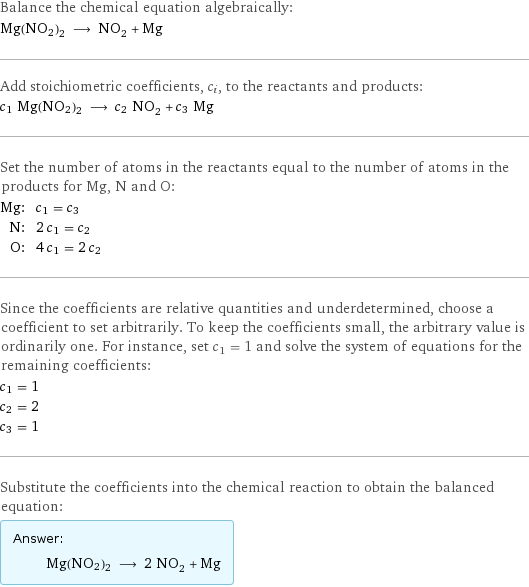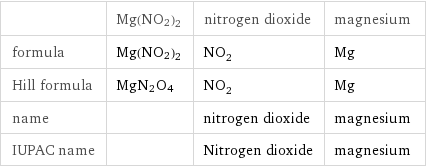Input interpretation

Mg(NO2)2 ⟶ NO_2 nitrogen dioxide + Mg magnesium
Balanced equation

Balance the chemical equation algebraically: Mg(NO2)2 ⟶ NO_2 + Mg Add stoichiometric coefficients, c_i, to the reactants and products: c_1 Mg(NO2)2 ⟶ c_2 NO_2 + c_3 Mg Set the number of atoms in the reactants equal to the number of atoms in the products for Mg, N and O: Mg: | c_1 = c_3 N: | 2 c_1 = c_2 O: | 4 c_1 = 2 c_2 Since the coefficients are relative quantities and underdetermined, choose a coefficient to set arbitrarily. To keep the coefficients small, the arbitrary value is ordinarily one. For instance, set c_1 = 1 and solve the system of equations for the remaining coefficients: c_1 = 1 c_2 = 2 c_3 = 1 Substitute the coefficients into the chemical reaction to obtain the balanced equation: Answer: | | Mg(NO2)2 ⟶ 2 NO_2 + Mg
Structures

Mg(NO2)2 ⟶ +
Names

Mg(NO2)2 ⟶ nitrogen dioxide + magnesium
Equilibrium constant
![Construct the equilibrium constant, K, expression for: Mg(NO2)2 ⟶ NO_2 + Mg Plan: • Balance the chemical equation. • Determine the stoichiometric numbers. • Assemble the activity expression for each chemical species. • Use the activity expressions to build the equilibrium constant expression. Write the balanced chemical equation: Mg(NO2)2 ⟶ 2 NO_2 + Mg Assign stoichiometric numbers, ν_i, using the stoichiometric coefficients, c_i, from the balanced chemical equation in the following manner: ν_i = -c_i for reactants and ν_i = c_i for products: chemical species | c_i | ν_i Mg(NO2)2 | 1 | -1 NO_2 | 2 | 2 Mg | 1 | 1 Assemble the activity expressions accounting for the state of matter and ν_i: chemical species | c_i | ν_i | activity expression Mg(NO2)2 | 1 | -1 | ([Mg(NO2)2])^(-1) NO_2 | 2 | 2 | ([NO2])^2 Mg | 1 | 1 | [Mg] The equilibrium constant symbol in the concentration basis is: K_c Mulitply the activity expressions to arrive at the K_c expression: Answer: | | K_c = ([Mg(NO2)2])^(-1) ([NO2])^2 [Mg] = (([NO2])^2 [Mg])/([Mg(NO2)2])](../image_source/f4ebc0c099f1b9fb24239d57713c51d8.png)
Construct the equilibrium constant, K, expression for: Mg(NO2)2 ⟶ NO_2 + Mg Plan: • Balance the chemical equation. • Determine the stoichiometric numbers. • Assemble the activity expression for each chemical species. • Use the activity expressions to build the equilibrium constant expression. Write the balanced chemical equation: Mg(NO2)2 ⟶ 2 NO_2 + Mg Assign stoichiometric numbers, ν_i, using the stoichiometric coefficients, c_i, from the balanced chemical equation in the following manner: ν_i = -c_i for reactants and ν_i = c_i for products: chemical species | c_i | ν_i Mg(NO2)2 | 1 | -1 NO_2 | 2 | 2 Mg | 1 | 1 Assemble the activity expressions accounting for the state of matter and ν_i: chemical species | c_i | ν_i | activity expression Mg(NO2)2 | 1 | -1 | ([Mg(NO2)2])^(-1) NO_2 | 2 | 2 | ([NO2])^2 Mg | 1 | 1 | [Mg] The equilibrium constant symbol in the concentration basis is: K_c Mulitply the activity expressions to arrive at the K_c expression: Answer: | | K_c = ([Mg(NO2)2])^(-1) ([NO2])^2 [Mg] = (([NO2])^2 [Mg])/([Mg(NO2)2])
Rate of reaction
![Construct the rate of reaction expression for: Mg(NO2)2 ⟶ NO_2 + Mg Plan: • Balance the chemical equation. • Determine the stoichiometric numbers. • Assemble the rate term for each chemical species. • Write the rate of reaction expression. Write the balanced chemical equation: Mg(NO2)2 ⟶ 2 NO_2 + Mg Assign stoichiometric numbers, ν_i, using the stoichiometric coefficients, c_i, from the balanced chemical equation in the following manner: ν_i = -c_i for reactants and ν_i = c_i for products: chemical species | c_i | ν_i Mg(NO2)2 | 1 | -1 NO_2 | 2 | 2 Mg | 1 | 1 The rate term for each chemical species, B_i, is 1/ν_i(Δ[B_i])/(Δt) where [B_i] is the amount concentration and t is time: chemical species | c_i | ν_i | rate term Mg(NO2)2 | 1 | -1 | -(Δ[Mg(NO2)2])/(Δt) NO_2 | 2 | 2 | 1/2 (Δ[NO2])/(Δt) Mg | 1 | 1 | (Δ[Mg])/(Δt) (for infinitesimal rate of change, replace Δ with d) Set the rate terms equal to each other to arrive at the rate expression: Answer: | | rate = -(Δ[Mg(NO2)2])/(Δt) = 1/2 (Δ[NO2])/(Δt) = (Δ[Mg])/(Δt) (assuming constant volume and no accumulation of intermediates or side products)](../image_source/317f241c5d3ad1a2daf72487c974797f.png)
Construct the rate of reaction expression for: Mg(NO2)2 ⟶ NO_2 + Mg Plan: • Balance the chemical equation. • Determine the stoichiometric numbers. • Assemble the rate term for each chemical species. • Write the rate of reaction expression. Write the balanced chemical equation: Mg(NO2)2 ⟶ 2 NO_2 + Mg Assign stoichiometric numbers, ν_i, using the stoichiometric coefficients, c_i, from the balanced chemical equation in the following manner: ν_i = -c_i for reactants and ν_i = c_i for products: chemical species | c_i | ν_i Mg(NO2)2 | 1 | -1 NO_2 | 2 | 2 Mg | 1 | 1 The rate term for each chemical species, B_i, is 1/ν_i(Δ[B_i])/(Δt) where [B_i] is the amount concentration and t is time: chemical species | c_i | ν_i | rate term Mg(NO2)2 | 1 | -1 | -(Δ[Mg(NO2)2])/(Δt) NO_2 | 2 | 2 | 1/2 (Δ[NO2])/(Δt) Mg | 1 | 1 | (Δ[Mg])/(Δt) (for infinitesimal rate of change, replace Δ with d) Set the rate terms equal to each other to arrive at the rate expression: Answer: | | rate = -(Δ[Mg(NO2)2])/(Δt) = 1/2 (Δ[NO2])/(Δt) = (Δ[Mg])/(Δt) (assuming constant volume and no accumulation of intermediates or side products)
Chemical names and formulas

| Mg(NO2)2 | nitrogen dioxide | magnesium formula | Mg(NO2)2 | NO_2 | Mg Hill formula | MgN2O4 | NO_2 | Mg name | | nitrogen dioxide | magnesium IUPAC name | | Nitrogen dioxide | magnesium
Substance properties

| Mg(NO2)2 | nitrogen dioxide | magnesium molar mass | 116.31 g/mol | 46.005 g/mol | 24.305 g/mol phase | | gas (at STP) | solid (at STP) melting point | | -11 °C | 648 °C boiling point | | 21 °C | 1090 °C density | | 0.00188 g/cm^3 (at 25 °C) | 1.738 g/cm^3 solubility in water | | reacts | reacts dynamic viscosity | | 4.02×10^-4 Pa s (at 25 °C) |
Units
